Pai Gow Tiles - Part 1 of 3 - Rules of the Game
[00:00:12] Michael Shackleford: Hi, I'm Mike Shackleford, also known as the Wizard of Odds and I'm joined here by my friend Heather Ferris. Heather is also the videographer for this production, and my favorite Pai Gow dealer in all of Las Vegas, all of the world for that matter, Tess.
[00:00:28] Tess Dunn: Hi.
[00:00:29] Michael: So, this is part one of my three videos on Pai Gow
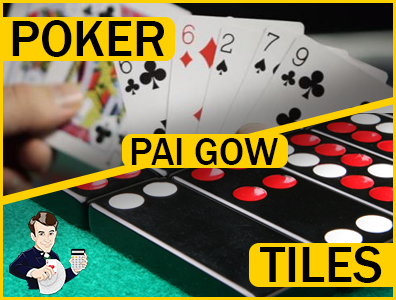
First, a word about the name:
The name of this game is Pai Gow. Pai Gow Poker is the game played with cards, so please never call Pai Gow Poker just Pai Gow, because Pai Gow is this game, one of my many pet peeves in the casino. I would also like to make a remark before we start, that this is obviously not being dealt on a Pai Gow table.
My friends at Galaxy Gaming were kind enough to let me use their studio to make this video, but they don't have a Pai Gow table so we're using this Dueling for Dollars table.
It doesn't really matter…
…because for betting purposes in Pai Gow, you just make one bet. There's rarely side betting, no raising, its just one bet. That's about the only simple thing about the game, just to warn you. Like I said, this is part one of three parts.
- In part one - we'll be going over the rules
- Part two - we'll be talking about strategy.
- At part three - we'll be going over some esoteric details for the experts in the game.
Let's jump right into the rules, shall we, Heather?
[00:01:44] Heather Ferris: Definitely.
[00:01:46] Michael: Pai Gow is played with 32 tiles. The 32 tiles are separated into 16 pairs. Most of the pairs look the same, like these, but some of them do not.
For example:
This would be the mixed eight pair, notice how one has six and two, and one has five and three. Nevertheless, every tile is part of a pair, and it is critical to playing the game to understanding the order of the pairs.
You can always:
Sit down at the table and ask the dealer how to play any given hand, but I think that it's not going to be fun unless you have an understanding for the rules of the game. You can't not know the hand order in this game to play it properly.
Unlike playing cards, there is no easy memory device to the order of the pairs. There are some things you can do to help memorize it, but for the most part it simply must be memorized. Let me tell you at least some patterns that you can see in the order of the pairs.
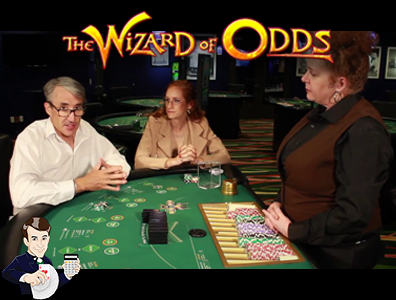
This is the highest pair, it's called Gee Joon
These tiles are both semi wild, they can be worth three or six points. They're the only wild tiles in the game. The way I might remember this is that both tiles are composed of numbers that are powers of two, meaning an integer to the power of any other integer, so one, two, four, eight, 16, 32 and so on.
Again, these are special. They can be worth three or six points.
Next, the second highest pair
This is called the team pair, or in English it translates to "the heaven pair". It consists of 12 dots. Third is what's called the day pair, it consists of two dots. Fourth is the-- I call it the high eight pair. The high four pair. The high 10 pair. The high six pair.
The low four pair, and it's low because this one here is higher ranking. The only 11 pair. The low 10 pair. The high seven pair. The low six pair. The only nine pair. Low eight pair. Low seven pair, and the only five pair. The team pair and the day pair are also special tiles which I will explain later, but remember that all the special ones are the highest ranking.
After that, one thing you might want to remember…
…is, you notice how this one is all red, you have an all red pair coming right after it, then comes the high four pair. I have no trick to memorizing that one, it just falls out of place in my opinion, but nevertheless, it is what it is. Then comes the all-white pairs, the 10, the six, the four and the 11. You can think of it going in order, except the 11.
For example:
It goes 10, then lower to six, then lower to four, but then it goes all the way up to 11. Why? I have no idea. Then comes three sets of tiles that are half white, half red, the 10, the seven and the six and these conveniently go from the highest number of dots to the least.
Then come your mixed pairs
These pairs, the two tiles add up to the same number of points, but they're different. For example, this nine pair, one is composed of a six and a three, and the other of five and a four. Then the mixed eight pair, the mixed seven pair and the mixed five pair. There you have it.
Tess, do you have any other suggestions on ways this might be memorized?
Anything you help players with?
[00:06:24] Tess: I like the way you have it. Then once you get to the all-white pair, and then when you get to the 11, which seems out of place, you can think of another descent down after that, 11, 10, seven, six. Low, high, low and then on to the mixed pairs.
[00:06:41] Michael: Yes, I like that.
[00:06:42] Tess: To descent down again, nine, eight, seven, five.
[00:06:47] Michael: Yes, so most of it is descent. Here's one descent.
[00:06:52] Tess: Yes.
[00:06:53] Michael: Then this one, and then this one. There you go. Also, here is a quick other way to memorize it, and this is like the story of creation. This pair represents God, because it's the highest.
The first thing…
…God did was create the heavens, and these look like the heavens because it looks like lots of stars. God created the Earth, and each one of these dots could represent the Earth. Then God created man. Why this is a man, I'm not sure.
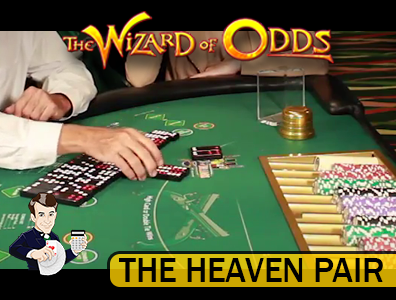
Then God:
Created animals for man to eat and this represents a goose. I think of it as this being the gooses head, and this part being the gooses feathers. Then God created flowers to give the Earth beauty, and each one of these looks like a flower.
God gave man clothing or robes, to give him something to wear, and this looks like a robe where it's wide in the waist. Then God gave man benches to sit on, and I guess that these two twos represent the legs of the bench.
Then
God gave man a hatchet to start building things, and it's a little hard for me to see how this is a hatchet, but I guess this is the handle and this part is wood chips flying all over the place.
Then man wanted to build houses and not just houses, but have houses with rooms in them. These represent partitions to give different rooms in man's house.
Then, once man had a house that had separate rooms in it, he may as well have a family to fill in these rooms.
This one represents God's first child, who had long legs, so these are the long legs and this is his head. To be perfectly honest with you, I forgot how this six fits into the story, but that's God's second child. Then man created the military, and in Pai Gow the military is lower than, I guess, civilians.
That's where you get all these mixed pairs. You can always remember the mixed ones are lowest, but the higher the pair the higher the rank.
Tess, do you have anything to add to that story?
[00:09:34] Tess: No, I think you pretty well summed it up, Mike. Very good.
[00:09:37] Michael: Thank you. Have you heard that story before?
[00:09:39] Tess: I have not, yes.
[00:09:41] Michael: Okay. Well, we're all learning something.
[00:09:42] Tess: Yes, we are, today.
[00:09:46] Michael: Before I go further...
Let me explain the big structure of the game, which is similar to Pai Gow Poker. Every player and the dealer will each receive four tiles and separate them into a two-tile high hand, and a two-tile low hand. The player's high pair will be compared to the, I should say, high hand.
The player's high hand will be compared to the dealer's high hand, the player's low hand will be compared to the dealer's low hand. The complicated part about the rules is knowing the order of all the possible hands.
I've already gone through the highest ones, the pairs. Just below the pairs is something called a Wong. A Wong, remember how I said the two and 12 tile are special? Well, to make it a Wong, you must use either the two tile or 12 tile and a nine tile. Both of these are Wongs.
Just remember:
Two or 12 and a nine. Why? I have no idea. Do you know, Tess, why they introduced this rule into the game?
[00:10:59] Tess: No, Mike, I do not. I know that with this game there are a lot of things you will never have an answer to. You just have to accept that's the way it is. That's the way the game is structured, and it is that way.
[00:11:14] Michael: Mine is not to question why. Okay. Just beneath the Wongs is something similar called a Gong. A Gong is either the two or the 12, again, remember, those are special, and any eight-point tile. It doesn't matter whether it's the low eight or the high eight. This is a Gong. This is a Gong.
I could…
…switch these eights around, it doesn't matter. As long as there's a two or a 12 tile, one of these special ones, and any eight tile. Again, why someone in China probably 1,000 years ago thought to put in this rule, I have no idea.
Nevertheless, it's there, Wongs and Gongs. You can't forget them, they're a critical part of the game. They often turn what would normally be an awful hand into a good hand. Of course, it cuts the same for the dealer too.
[00:12:14] Tess: Yes, it does.
[00:12:15] Michael: Yes. Okay. If you can't make a pair, a Wong or Gong, then it becomes like Baccarat where all you have to do is count the dots and if it goes over nine, you just look at the terminal digit of the total.
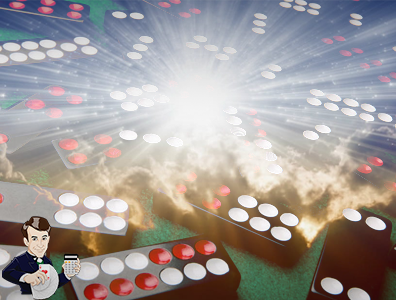
For example:
If you had a seven and a six, the total is 13, it's worth three points. You just subtract off the 10. If you had a 10 and a nine, it's a total of 19, subtract off the 10 and it's worth nine points. Just below a Gong, it goes by the total number of points.
The higher the number of points, the higher the score. For example, just below the Gong would be nine-point hands, and just below that eight, and below that seven, all the way down to zero. That's basically the hand order.
One rule that comes into play a lot is:
If the player and the dealer have the same number of points or they both have a Gong or they both have a Wong, then the dealer will look at the highest tiles to break the pair. For example, if Tess had this and I had this, they're both worth nine points, because again, you add up the dots, well, in this case it's 19, so you subtract 10 and it's nine.
Here, that adds up to nine naturally. So, they're both nine-point hands. In this case, you look at the high tile to break the tie. As I just explained with the pairs, this outranks that, so that one would go to Tess.
You might be wondering
If the highest tile still doesn't break the tie, what if you had a situation like this? In this case, the win goes to the banker. I will talk more about banking later, but you do not look at the second highest tile. It does not matter. Although this tile outranks this one, they're both eclipsed by this higher tile, the 12 tile. This would be a copy and go to the banker, whoever may be banking.
The player does have the opportunity to bank in this game, much like in Pai Gow Poker. Fortunately, the order of the tiles for purposes of breaking ties is the same as the order of the pairs except the Gee Joon, highest pair. If you split that apart, then these tiles individually are the lowest ranking individual tiles. Why? I have no idea. Do you know, Tess?
[00:15:22] Tess: Again, there is no reason. It's that way because the game is structured that way. So, there you go. Who knew?
[00:15:32] Michael: Couldn't have said it better myself. Yet another exception to the rule is, if there's ever a zero-zero tie, it goes to whoever is banking, and it doesn't matter how the tiles are composed.
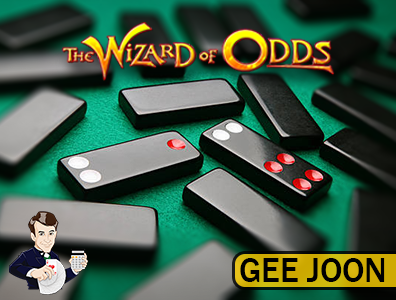
For example, if you had this situation
No, that's a bad situation, because this is a Gong. If Tess had this and I had this, this adds up to 20, in this case, you would drop the two and it's worth zero points. Here, 10 plus 10 is also 20, you dropped the first digit and you're left with zero. A zero against a zero always goes to the banker and it doesn't make any difference, the rank of the tiles within the zero-point hand.
Why? I don't know. Do you know, Tess?
[00:16:29] Tess: No. Again, Mike, you have me stumped once again. I do not have the answer to that.
[00:16:34] Michael: Yes. I have a lot of books on Pai Gow, and it seems like nobody knows the answer. Whoever invented this game 1,000 years ago took that secret with them to the grave, I'm afraid.
[00:16:46] Tess: It will remain a mystery.
[00:16:48] Michael: Okay. Well, I think that we've gone over the order of the hands pretty well. The only thing left to do is to explain the overall structure of the game. As I said before, everyone at the table, including the dealer, will get four tiles.
You separate it to a high hand and a low hand. High hand between the player and dealer are compared, the low against the low. If the player wins both ways, much like the banker bet in Baccarat or in Pai Gow Poker, the player will win even money less a 5% commission.
If it goes one each way, it's a push. If the dealer wins both ways, then the dealer wins. So, nice and simple, there's no raising, no side bets, it's just one bet is all you have to worry about.
Okay, Heather, any questions on the rules?
[00:17:44] Heather: Yes, I do. What is up with these red dots and white dots? Is there a difference between them or do they mean anything? Why are they there?
[00:17:55] Michael: The colors mean absolutely nothing to the game. They may as well all be painted the same color, it doesn't make any difference. It might help a little bit in terms of memorizing the hand order. For example, we see these all-white pairs in a row and then these mixed colors in a row, but you will notice that the only red on the game are these groupings of four and the grouping of just one, except the 12 tile, that has a combination of both.
There is some story…
…behind why the one and why the four are red, and it's not just in this game. With Chinese dice, like in Mahjong, the one and the four are also red. I'm not sure what the story is, but yes, again, the colors don't make any difference.
[00:18:50] Heather: Okay. Cool.
[00:18:52] Michael: All right. That covers the rules of the game. This was part one of my Pai Gow series. In part two, we're going to go over some strategy, and in part three, we'll go over some esoteric points to the game for the experts.
Again, I'm Mike Shackleford, the Wizard of Odds. My thanks to Galaxy Gaming for the use of their studio.
Check out ruwix.com to learn the solution of the Rubik's Cube and other twisty puzzles like Pyraminx, Square-1 etc.


